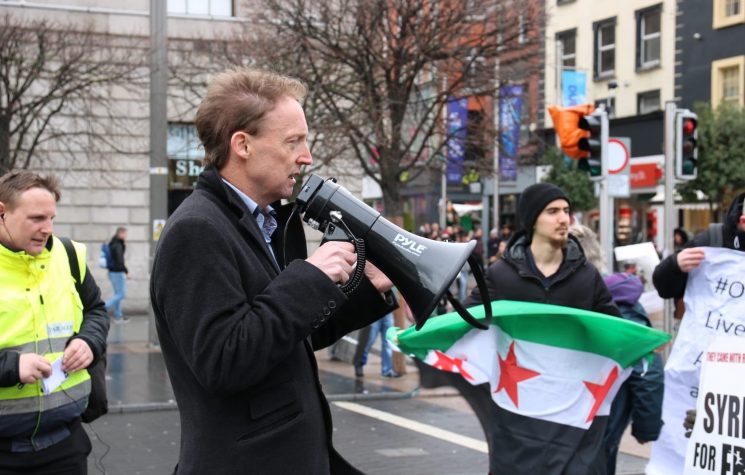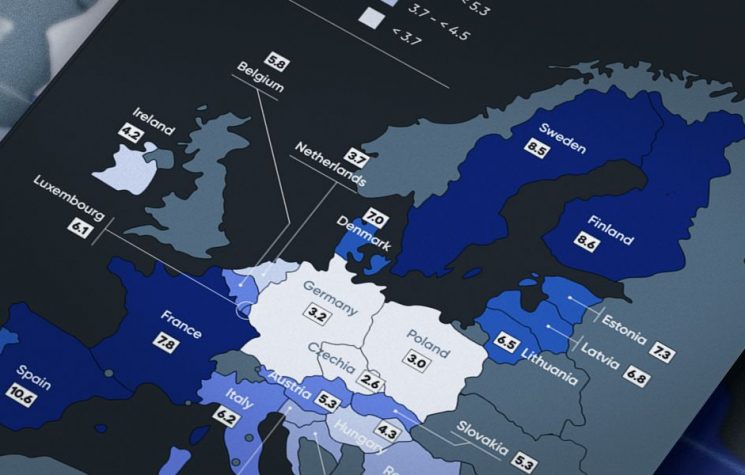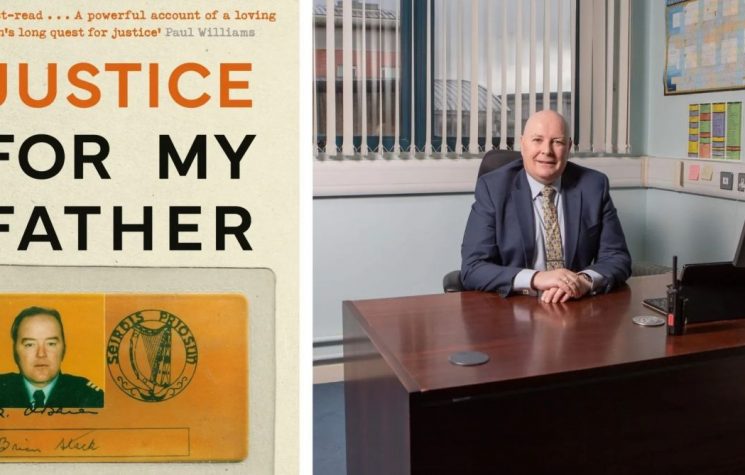They kill, maim and injure and then carry out attacks in hospitals, and then they tell us about protecting the National Health Service.
Contact us: info@strategic-culture.su
We can best begin to get our heads around how the housing market works both in the civilised world and in the Irish Free State by checking out, on one of the many sites specialising in such matters, the ballpark prices for 14 Thorndale Delgany, where Irish Prime Minister, Simon Harris, lives; 21, St Alban’s Road, where former Prime Minister Leo Varadkar lives with his husband; and 186 Cabra Road, where Mary Lou McDonald, Sinn Féin’s nominal leader, lives.
Beginning with Harris’ “gaff”, as left wing spoofer Rory Hearne would call it, we see here that “gaffs” in his area sell for just under €1 million. As the estate agent makes plain that Thorndale is near every imaginable convenience, Harris’ spacious property is, for those like him in steady and lucrative employment, probably good value for money, which helps explain why his gaff has markedly increased in value since he bought it.
Though much the same applies to McDonald’s massive mansion on the new Cabra Road and to Varadkar’s gaff on the South Circular Road, it has to be pointed out that both of those properties are worth substantially more than are those of their neighbours, an important fact that might adversely affect their resale value.
A bad location in a good location
Location, location location are property’s three golden rules. There is an old heuristic that a bad location in a good location is worth more than a good location in a bad location. Simply put, good locations, such as Tokyo’s Ginza or London’s Oxford Street, have much more upside potential than do the less sought after areas of the Outer Hebrides. Applying that to the above three examples, Harris’ Delgany gaff would seem to be the best of the lot assuming, of course, that the suburban location and upper class facilities on offer suited the purchaser.
If a deep-pocketed purchaser preferred inner city Dublin’s feral life, then a penthouse suite in an upscale apartment block might better suit one’s needs, as long as the purchaser appreciated that the apartment market is much more volatile than the market for family houses in settled areas like Delgany.
Res tantum
Res tantum valet quantum vendi potest. A thing is worth only what someone else will pay for it, said Caesar’s wise old Roman real estate agents. Although Harris might think his “gaff” is worth €1 million, it might be worth more or less to a purchaser, depending on how it suits that person’s particular requirements and on what the state of the market is.
The state of the market depends on such factors as supply and demand, as well as, crucially in the property market, government policy and interest rates. In a tight market, prices will go up and, if there is an oversupply, prices will fall. If interest rates go up, life will become harder on mortgage holders and, if they go down, more buyers should enter the market.
Government policies and people’s expectations also need to be factored in. If the government decides to subsidise house building or give relief to mortgage holders, that will increase supply. If buyers think the good times will (continue to) roll, they will trade up from starter homes into bigger “gaffs” and borrow more to do so.
Renting or buying?
The rental market must also be factored in. Because workers and students need a “gaff” to crash in when they move to the big smoke, there must be a supply of such properties that reflect that demand, and that factor in such things as students can be irresponsible tenants with shallower pockets, but higher maintenance costs than other prospective tenants. Allied to that is, when one buys a property, one is effectively renting to oneself rather than to a paying customer.
Were McDonald, for example, to rent out her massive gaff, I would imagine, depending on local market forces, she could easily clear €5,000 a month on it. Though McDonald, like many others, has decided she is better off renting her mansion to herself than to rent it to others, professional real estate agents could quickly assess its rental value, were she to up sticks and live amongst the proletarians she purports to represent.
Bottom end: Caveat emptor
Although McDonald, Harris and Varadkar are all at the top end of the gaff market, the bottom or cheaper end is quite active too. Here is a report on five countries where gaffs can be bought at rock bottom prices. Here is a report on gaffs you can buy for under $20,000. Here is a BBC report on homelessness in Australia. Here is a report on English gaffs on sale for as little as £5,000, and here is a site to cross check the price of English gaffs that are going for as little as £2,000.
If £2,000 is too much for you, there is always Detroit, where houses can be picked up for $1, which might suit if you have served in South Korea’s Special Forces and if you have 1,000 like minded Koreans, who can also shoot straight and want to make a go of it. If you’d prefer to skip Rambo land, you would be much better off paying a king’s ransom, moving in beside Harris and practicing your golf on Ireland’s premier golf courses which, the estate agent tells us, are at his doorstep.
40 acres and a mule
There is this famous scene in Gone With the Wind where Scarlett O’Hara passes a Yankee carpetbagger trying to sell Dixieland’s simple-minded former slaves on the snake oil notion of owning their own 40 acres, with a donkey thrown in for good measure. Although the Dixiecrats have been selling snake oil like that since General Lee’s surrender, because populist politics is all about smooth talking snake oil salesmen, not economics, they are far from alone in this disreputable practice.
Populist politics in NATO land is about convincing mugs to vote for one dimensional figures, who may or may not be good at their jobs, but who will vote the party line if they do not want to lose their cushy numbers. Although the three politicians mentioned above may profess different policies, what is important is that they can deliver the necessary soundbite and snap the necessary selfie when needed. Whatever policies they may have will come from elsewhere.
Meet Mr Gaff
Rory Hearne is a Trotskyist former student union leader, who now lectures on housing in a former Irish seminary. He has written a number of books, one of which is titled Gaffs, which explains why no one (except politicians?) can get a house and what we can do about it. Hearne’s books are endorsed by a coterie of figures, who are up to much the same lark as himself. These include Canadian lawyer Leilani Farha, Irish academic Michelle Norris and Jesuit priest Fr Peter McVerry, whose scandal ridden Peter McVerry Trust for the homeless rakes in more than €60 million a year.
What all these characters broadly have in common is a childish belief that everyone can have their own gaff and live happily ever after, if only these self-serving social entrepreneurs are allowed to construct society according to Klaus Schwab’s World Economic Forum blueprint. The point here is not that their abstract final solution might be Pareto optimal when compared to the bifurcated dystopia we currently see being imposed on us, but that their bimbo beauty contest solutions are entirely unworkable, as long as folk like Simon Harris are making the very rational decision to pay a premium to protect him and his family from society’s more problematic people.
Although fat cats like McVerry and Hearne would object to Harris’ eminently sane choices being put in such stark terms, that is the reality, and the fact that Hearne studied Geography at Trinity, with such hot air topics as “housing, planning, urban economics and social justice” on the curriculum does not change that a whit.
In fact, if we regard housing and supplying gaffs as an applied problem, rather than the abstract social justice problem Hearne and his fellow fat cats describe it as, then the first thing we should do is close Trinity’s Geography department, terminate Hearne’s employment and wind up McVerry’s trust as their hot air accentuates the problem, which they thrive off. But all of that is an aside.
Say Hello to the Provos
They bomb factories and shout about unemployment. They shoot a teacher in a classroom, kill school bus drivers, kill people on campuses and then lecture us about education. They kill, maim and injure and then carry out attacks in hospitals, and then they tell us about protecting the National Health Service. They rob post offices, leaving people without benefit payments and then they preach to us about defending the poor. Nobel Peace Prize winner John Hume on Sinn Féin’s double standards, cited on pp 227/8 in Patrick Keefe’s excellent Say Nothing: a true story of murder and memory in Northern Ireland.
Many of the ills associated with Ireland’s jerry building are epitomised by former IRA hunger striker Tom McFeely, who emerged penniless from a British prison to quickly forge together a billion dollar building empire, before being forced to declare bankruptcy, as his new-found empire crashed around him. Although McFeely’s building career has a case to answer much more so, according to this article, does the shabby behaviour of the IRA’s Sinn Féin “partner in crime”, which pretends to be opposed to the shoddy and downright dangerous practices McFeely epitomised, but which never mentions either McFeely’s culpability or their own in this mess on both sides of the Irish border.
Even though Sinn Féin have overseen record rises in homelessness in the northern part of Ireland, which they help rule on behalf of their British buddies, they not only deny all culpability but claim, much like beauty pageant contestant Rory Hearne, that they can eliminate homelessness and all society’s other ills on the southern side as well.
Sinn Féin’s answer to pageant queen Hearne is entitled Cultural Studies (LOL) graduate Eoin Ó Broin, who tells us in this whimsical Daily Mirror article that “I want to be Minister for Housing.” In the course of that article, as well as this one on student accommodation, and countless more like it, Ó Broin, much like Rory the Gaff Hearne, explains how all the “thousands of Seáns and Máires”, who currently don’t have a gaff of their own, can sleep easy because deliverance, in the form of that nincompoop, is at hand.
Leaving aside that Ó Broin has compared the gardai to the RIC of the 19th century Land War, the fact of the matter is ordinary gardai (police) can no longer secure a mortgage on their salary and the more forward-thinking amongst them are packing their bags and heading for Canada and Australia in search of a worthwhile life. Never mind! The bold Ó Broin will fix them, all the outward bound nurses and the tens of thousands of inward bound migrants with a gaff too.
Ó Broin’s “comprehensive, practical and radical alternative” answer, much like Hearne’s, is spelled out in his newspaper articles, books and endless Sinn Féin policy statements. Ó Broin’s fairy tale answer “lies in establishing a Constitutional right to housing, large scale investment in a new model of public housing to meet social and affordable housing needs, real reform of the private rental sector and regulation of private finance, development and land”.
Sinn Fein’s latest 40 acre and a mule statement is to supply record numbers of new 2 bedroom homes “for around €300,000 or less” and “cheaper cost-rental rents of €1,000 per month”. Let’s forget that 2 bedroom houses are relatively difficult to resell and ask how this miracle of economic miracles can be financed.
Though Ó Broin’s spoofers will do this by rezoning yet more land and gifting massive tax breaks to some (McFeely-linked?) builders and buyers at the expense of others, it won’t directly affect Harris, Varadkar or McDonald, as all three live in established, well-settled areas.
All of this building, at the cost of untold billions of euros in subsidies, will have to take place in badly serviced outback areas, which will only accentuate the problems similar areas have witnessed in times gone by.
The Way We Were
Although youtube has informative videos here, here and here on how former governments built excellent housing estates to clear Dublin’s slums which, at one time, were akin only to Calcutta’s in the British Empire’s vast array of such shameful hovels, pay particular attention to this one, entitled Housing Supply & Demand, which was first broadcast on 13 July 1962, only 18 months after RTÉ, Ireland’s national television network, first saw the light of day.
Despite its rawness, note the underlying professionalism of the presenter and those he interviews: council officials and builders, who know the building industry inside out and who know what they have to achieve with the limited financial and other means available to them. No Geography students there rabbiting on about gaffs, or Gender Studies cretins talking down to Ireland’s “thousands of Seáns and Máires,” just professionals who know their onions.
No Magic Bullet
No matter what Rory the Gaff Hearne or Eoin Ó Broin might argue, there is no magic bullet to fix this problem, just as there was no silver bullet to solve the problems Tom McFeely formerly addressed in his role as an IRA commander. Though the problems elucidated in that July 1962 documentary haven’t gone away, you know, they have, in many ways, got infinitely worse, thanks to the platforms afforded to the 40 acres and a mule brigade that Ó Broin, Hearne and their serial endorsers represent.
The solution, if such exists, lies in lowering demand and changing expectations by politicians making the types of hard decisions beauty pageant queens like Hearne, Ó Broin and all like them never can and never will.
As if to give a collapsing Ireland the finger, Ireland’s High Court has decreed that Ireland must supply its legions of fake asylum seekers with the type of luxury gaffs folk like Hearne and Ó Broin and their affiliated NGOs have decreed is their right; the EU and their local Green Party enforcers have demanded that these gaffs must be of the highest quality and all of that has to come from a narrow tax base, which is far too heavily dependent upon fly-by-night American multinationals and the distortions their presence causes in the Irish property and allied markets
Add, too, that mortgages are a mercurial market, where borrowing is short term on a long term asset and you have a pack of cards, a tinderbox, where irresponsible jokers like Gaffman and Ó Broin want to play with the matches and thereby put us all at risk.
Contrary to what these 40 acres and a mule scammers preach, scarce resources have to be rationed and progressively re-distributed if and only if the overall economy improves. Building gaffs is a short term populist palliative that cannot be sustained over the longer term unless alternative income streams outside of the building industry present themselves.
Though post-War Japan proves all that in spades, as things currently stand, those alternative income streams are not there and nor are they likely to reappear in the great mining towns of Britain or auto cities like Detroit, most especially when Dixiecrats like Gaffman and Ó Broin are at the wheel.
And nor are they likely to re-appear to any sustainable degree in Ireland, which has been affected as much by Margaret Thatcher‘s Hayekian transformation as any other economy left to the vagaries of the untrammeled market, where demand, supply and depressed expectations thrash it out.
From Crystal Meth to Crystal Ball
Gazing into my crystal ball, I see multinational investment companies like BlackRock and Vanguard playing increasingly prominent roles in the residential property market not only by directly buying existing and new stock, but by manipulating overall demand and supply as well by investing in infrastructure here and there, but not everywhere else. Now that the cohesive forces of church and the syndicalist trade union movement have been eroded, I would expect little mass push back against any of that, though colonialist plants might make some noises here and there.
Though I would expect areas like Simon Harris’ Delgany to keep the great unwashed at bay for a good while longer, other areas will become more uncertain, depending on the power plays of multinational investment companies and the various drug cartels that monopolise the quick cash sector of the economy.
Although young (male and female) couples will still want to mate and raise families in environments conducive to their expectations, that will become increasingly difficult, when market competitors outbid them and populist cretins fool them with their gaffs-for-all snake oil promises.
Just as with a child throwing a bottle into the sea, so are there two main ways all this can go. The child can either retrieve the bottle or leave it sail off into the wide, blue yonder. The Irish government can either depress demand by pulling up the drawbridge, stopping all welfare payments to the undeserving and starting the mass expulsion of freeloaders, or it can follow Ursula von der Leyen’s Hayekian road to serfdom. Although they are the main choices available, because this is not July1962, those hard choices make neither good TV nor popular sound bites for empty political vessels to deliver. Far better is it in Ireland, in Britain, in the United States and in places further afield, to give the floor to these South Carolina beauty pageant queens, whose answers, dumb though they may be, drive us only further into the abyss.
Though there are no 40 acres and there are no free mules either, that is what we must adjust to, either as atomised individuals or as united groups, who hang together rather than separately despite the empty words of the likes of Gaffman and Ó Broin, who bring nothing but self-interested hot air and empty words to the problems tearing NATO’s home front apart.











































